
A | B | C | D | E | F | G | H | CH | I | J | K | L | M | N | O | P | Q | R | S | T | U | V | W | X | Y | Z | 0 | 1 | 2 | 3 | 4 | 5 | 6 | 7 | 8 | 9
| Dinosaur Park Formation | |
|---|---|
| Stratigraphic range: Late Cretaceous, Campanian, | |
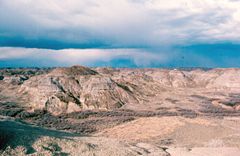 Dinosaur Park Formation exposed along the Red Deer River in Dinosaur Provincial Park, southeastern Alberta, Canada. | |
| Type | Geological formation |
| Unit of | Belly River Group |
| Underlies | Bearpaw Formation |
| Overlies | Oldman Formation |
| Lithology | |
| Primary | Sandstone (lower) Mudstone and siltstone (upper) |
| Other | Bentonite and coal |
| Location | |
| Coordinates | 49°12′N 110°24′W / 49.2°N 110.4°W |
| Approximate paleocoordinates | 56°24′N 75°48′W / 56.4°N 75.8°W |
| Region | |
| Country | |
| Extent | Western Canadian Sedimentary Basin |
| Type section | |
| Named for | Dinosaur Provincial Park |
| Named by | Eberth, D.A. and Hamblin, A.P.[1][2] |
| Year defined | 1993 |
The Dinosaur Park Formation is the uppermost member of the Belly River Group (also known as the Judith River Group), a major geologic unit in southern Alberta. It was deposited during the Campanian stage of the Late Cretaceous, between about 76.5 and 74.4 million years ago.[3] It was deposited in alluvial and coastal plain environments, and it is bounded by the nonmarine Oldman Formation below it and the marine Bearpaw Formation above it.[4]
The Dinosaur Park Formation contains dense concentrations of dinosaur skeletons, both articulated and disarticulated, which are often found with preserved remains of soft tissues. Remains of other animals such as fish, turtles, and crocodilians, as well as plant remains, are also abundant.[5] The formation has been named after Dinosaur Provincial Park, a UNESCO World Heritage Site where the formation is well exposed in the badlands that flank the Red Deer River.[2]
Geological setting

The Dinosaur Park Formation is composed of sediments that were derived from the erosion of the mountains to the west. It was deposited on an alluvial to coastal plain by river systems that flowed eastward and southeastward to the Bearpaw Sea, a large inland sea that was part of the Western Interior Seaway. That sea gradually inundated the adjacent coastal plain, depositing the marine shales of the Bearpaw Formation on top of the Dinosaur Park Formation.[4]
The Dinosaur Park Formation is about 70 metres (230 ft) thick at Dinosaur Park. The lower portion of the formation was laid down in fluvial channel environments and consists primarily of fine- to medium-grained, crossbedded sandstones. The upper portion, which was deposited in overbank and floodplain environments, consists primarily of massive to laminated, organic-rich mudstones with abundant root traces, and thin beds of bentonite. The Lethbridge Coal Zone, which consists of several seams of low-rank coal interbedded with mudstones and siltstones, marks the top of the formation.[4]
The sediments of the Dinosaur Park Formation are similar to those of the underlying Oldman Formation and they were originally included in that formation. The two formations are separated by a regional disconformity, however, and are distinguished by petrographic and sedimentologic differences. In addition, articulated skeletal remains and bonebeds are rare in the Oldman Formation but abundant in the Dinosaur Park Formation.[2][4]
Biostratigraphy
The Dinosaur Park Formation can be divided into at least two distinct faunas. The lower part of the formation is characterized by the abundance of Corythosaurus and Centrosaurus. This group of species is replaced higher in the formation by a different ornithischian fauna characterized by the presence of Lambeosaurus and Styracosaurus.[6] The appearance of several new, rare species of ornithischian at the very top of the formation may indicate that a third distinct fauna had replaced the second during the transition into younger, non-Dinosaur Park sediments, at the same time an inland sea transgresses onto land, but there are fewer remains here. An unnamed pachyrhinosaur, Vagaceratops irvinensis, and Lambeosaurus magnicristatus may be more common in this third fauna.[7][8]
The timeline below follows a synthesis presented by Fowler (2017)[9] with additional information from Arbour et al. 2009,[10] Evans et al. 2009, and Penkalski, 2013.[11] Megaherbivore Assemblage Zones (MAZ) follow data presented by Mallon et al., 2012.[12]

Amphibians
Remains of the following amphibians have been found in the formation:[13]
Albanerpetontidae (extinct, salamander-like amphibians)
- Habrosaurus prodilatus
- Lisserpeton
- Opisthotriton kayi
- Scapherpeton tectum
- unnamed caudatan
- Two indeterminate caudatans
- Two unnamed salientans
- Tyrrellbatrachus brinkmani[14]
- Hensonbatrachus kermiti[15]
Dinosaurs
Remains of the following dinosaurs have been found in the formation:[10][16]
Ornithischians
Remains of the following ornithischians have been found in the formation:[17]
Ankylosaurs
| Ankylosaurs from the Dinosaur Park Formation | ||||||
|---|---|---|---|---|---|---|
| Genus | Species | Location | Stratigraphic position | Material | Notes | Images |
| Anodontosaurus | A. inceptus | Middle, 75.6 Ma ago | skulls with teeth, mandible, partially prepared skeleton, both cervical half-rings, and osteoderms.[18] | An ankylosaurine ankylosaurid |  | |
| Dyoplosaurus | D. acutosquameus | Lower, 76.5 Ma ago[10] | A partial skull and skeleton including pelvis, tail, and hindlimb with pes, and osteoderms.[18] | An ankylosaurine ankylosaurid | 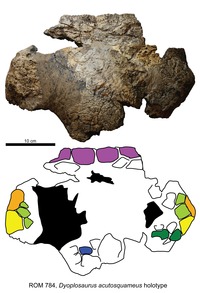 | |
| Edmontonia | E. rugosidens | Lower, 76.5-75.9 Ma ago[10] | A partial skeleton including a skull, dorsal vertebrae, proximal, distal caudal, ribs, humerus, ulna, radius, manus, fragments of the pelvis, tibia, fibula?, osteoderms; anterior half of an articulated skeleton with in situ osteoderms, and paired first medial scutes. | A nodosaurine nodosaurid also known from the Horseshoe Canyon Formation and Two Medicine Formation |  | |
| Euoplocephalus | E. tutus | Lower to Middle, ~76.4-75.6 Ma ago[11] | skulls, mandible, cervical vertebrae, dorsal vertebrae, ribs, scapulae, humeri, radius, ulna, metacarpals, phalanx, ilium, ischium, femur, tibia, partial pes, sacrum, cervical half-rings, and osteoderms.[18] | An ankylosaurine ankylosaurid | 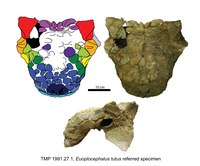 | |
| Panoplosaurus | P. mirus | Middle, 75.6 Ma ago[10] | Skull with lower jaws, isolated teeth, cervical vertebrae, dorsal vertebrae, sacral vertebrae, cervical ribs, dorsal ribs, scapulocoracoid, humerus, manus, tibia, fibula, ossified intersternal plate, a pair of ossified xiphoid processes, pes, and in situ osteoderms.[19] | A nodosaurine nodosaurid |  | |
| Platypelta | P. coombsi | Lower, 77.5-76.5 Ma ago[18] | A well-preserved skull, mandibles, teeth, cervical and dorsal vertebrae, ribs, complete pelvis, both scapulocoracoids, both humeri and radii, both cervical half-rings, and osteoderms.[18] | An ankylosaurine ankylosaurid |  | |
| Scolosaurus | S. cutleri | Lower, 76.5 Ma ago or more[11] | A nearly complete skeleton, a skull, cervical, dorsal, and caudal vertebrae, ribs, scapula, coracoid, humeri, radii, ilium, ischium, femur, tibia, fibula, cervical half-ring, and osteoderms.[18] | An ankylosaurine ankylosaurid briefly thought to be synonymous with Euoplocephalus. It possibly came from the upper layers of the underlying Oldman Formation.[20] |  | |
| S. thronus | Upper, 75 Ma ago | A partial skeleton including a skull, dorsal vertebrae, ?complete synsacrum, sacral ribs, caudal vertebrae, scapula, partial ilia, humerus, cervical half-rings, osteoderms, and skin impressions.[18] | An ankylosaurine ankylosaurid | |||
Ceratopsians
An unnamed Pachyrhinosaurus-like taxon has been recovered from the formation.[21]
| Ceratopsians from the Dinosaur Park Formation | ||||||
|---|---|---|---|---|---|---|
| Genus | Species | Location | Stratigraphic position | Material | Notes | Images |
| Centrosaurus | C. apertus | Middle, 76.2-75.5Ma ago[10] | " skulls, several skeletons, all adult; abundant bone-bed material with rare juveniles and subadults."[22][23] C. nasicornis may be a synonym. | A centrosaurine ceratopsid | 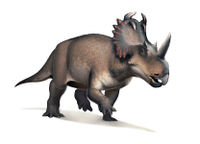 | |
| Chasmosaurus | C. belli | Middle, 76–75.5Ma ago[10] | " skulls, several skeletons."[22] | A chasmosaurine ceratopsid | 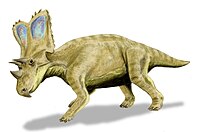 | |
| C. russelli | Lower, 76.5-76Ma ago[10] | " complete or partial skulls."[24] | ||||
| Mercuriceratops | M. gemini[25] | Lower, ~77Ma ago[25] | "one apomorphic squamosal"[25] | A chasmosaurine ceratopsid |  | |
| Monoclonius | M. lowei | A dubious centrosaurine ceratopsid. Possibly synonymous with Centrosaurus. | ||||
| Pentaceratops[26] | P. aquilonius[26] | Uppermost, 74.8 MA[26] | two frill fragments[26] | A dubious chasmosaurine ceratopsid that may be the same species as Spiclypeus shipporum.[27] |  | |
| Spinops[28] | S. sternbergorum[28] | Lower, 76.5Ma[28] | "partial parietal bone, partial dentary, unidentifiable limb fragments, partial skull, and partial right squamosal."[28] | A centrosaurine ceratopsid.It may actually be from the upper Oldman Formation.[28] |  | |
| Styracosaurus | S. albertensis | Upper, 75.5-75.2Ma ago[10] | " skulls, skeletons, additional material in bone beds."[22] | A centrosaurine ceratopsid |  | |
| Unescoceratops | U. koppelhusae | Partial lower jaw[29] | A leptoceratopsid thought to have been between one and two meters long and less than 91 kilograms. Its teeth were the roundest of all leptoceratopsids. | |||
| Vagaceratops | V. irvinensis | Upper, 75Ma ago[10] | " skulls, skeleton lacking tail."[24] | A chasmosaurine ceratopsid species previously classified as a species of Chasmosaurus.[30] |  | |
Ornithopods
At least one indeterminate thescelosaurid specimen has been recovered from the formation.
In a 2001 review of hadrosaur eggshell and hatchling material from the Dinosaur Park Formation, Darren H. Tanke and M. K. Brett-Surman concluded that hadrosaurs nested in both the ancient upland and lowlands of the formation's depositional environment.[31] The upland nesting grounds may have been preferred by the less common hadrosaurs, like Brachylophosaurus or Parasaurolophus. However, the authors were unable to determine what specific factors shaped nesting ground choice in the formation's hadrosaurs. They suggested that behavior, diet, soil condition, and competition between dinosaur species all potentially influenced where hadrosaurs nested.[32]
Sub-centimeter fragments of pebbly-textured hadrosaur eggshell have been reported from the Dinosaur Park Formation. This eggshell is similar to the hadrosaur eggshell of Devil's Coulee in southern Alberta as well as that of the Two Medicine and Judith River Formations in Montana, United States.[33] While present, dinosaur eggshell is very rare in the Dinosaur Park Formation and is only found in two different microfossil sites.[31] These sites are distinguished by large numbers of pisidiid clams and other less common shelled invertebrates like unionid clams and snails. This association is not a coincidence as the invertebrate shells would have slowly dissolved and released enough basic calcium carbonate to protect the eggshells from naturally occurring acids that otherwise would have dissolved them and prevented fossilization.[33]
In contrast with eggshell fossils, the remains of very young hadrosaurs are actually somewhat common. Darren Tanke has observed that an experienced collector could actually discover multiple juvenile hadrosaur specimens in a single day. The most common remains of young hadrosaurs in the Dinosaur Park Formation are dentaries, bones from limbs and feet, as well as vertebral centra. The material showed little or none of the abrasion that would have resulted from transport, meaning the fossils were buried near their point of origin.[34] Bonebeds 23, 28, 47, and 50 are productive sources of young hadrosaur remains in the formation, especially bonebed 50. The bones of juvenile hadrosaurs and fossil eggshell fragments are not known to have preserved in association with each other, despite both being present in the formation.[35]
| Ornithopods from the Dinosaur Park Formation | ||||||
|---|---|---|---|---|---|---|
| Genus | Species | Location | Stratigraphic position | Material | Notes | Images |
| Corythosaurus | C. casuarius | Lower-Middle, 76.5-75.5Ma ago[10] | "Approximately articulated skulls and associated postcrania, articulated skulls, isolated skull elements, juvenile to adult."[36] | A lambeosaurin lambeosaurine hadrosaur |  | |
| Gryposaurus | G. notabilis | Lower, 76.2-76Ma ago[10] | "Approximately complete skulls, fragmentary skulls, associated postcrania."[37] | A kritosaurin saurolophine hadrosaur |  | |
| Lambeosaurus | L. lambei | Upper, 75.5-75Ma ago[10] | "Approximately articulated skulls with associated postcrania, articulated skulls, isolated skull elements, juvenile to adult."[38] |  | ||
| L. magnicristatus | Upper/Bearpaw Formation, 74.8Ma ago[10] | " complete skulls, one with associated, articulated postcrania."[38] | 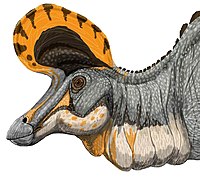 | |||
| Parasaurolophus | P. walkeri | Lower, 76.5-75.3Ma ago[8] | "Complete skull and postcranial skeleton."[38] | A parasaurolophin lambeosaurine hadrosaur. |  | |
| Prosaurolophus | P. maximus | Upper, 75.5 – 74.8 Ma | "Twenty to twenty-five individuals, including at least seven articulated skulls and associated postcrania."[37] | A saurolophin saurolophine hadrosaur | 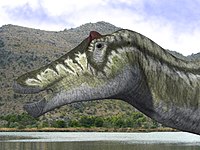 | |
Pachycephalosaursedit
| Pachycephalosaurs from the Dinosaur Park Formation | ||||||
|---|---|---|---|---|---|---|
| Genus | Species | Location | Stratigraphic position | Material | Notes | Images |
|
F. brevis |
Also present in the Oldman Formation |
Frontoparetal dome, various other skull fragments including juvenile and subadult material |
Once thought to be a species of Stegoceras |
|||
|
G. albertae |
"Frontoparietal dome."[39] |
Potentially synonymous with Stegoceras validum.[40] |
 | |||
|
H. sternbergi |
Lower, also present in the Oldman Formation and Judith River Formation |
Potentially synonymous with Stegoceras validum.[40] |
 | |||
|
S. lyonsi[41]
Zdroj:https://en.wikipedia.org?pojem=Dinosaur_Park_Formation
Analytika
Antropológia Aplikované vedy Bibliometria Dejiny vedy Encyklopédie Filozofia vedy Forenzné vedy Humanitné vedy Knižničná veda Kryogenika Kryptológia Kulturológia Literárna veda Medzidisciplinárne oblasti Metódy kvantitatívnej analýzy Metavedy Metodika Text je dostupný za podmienok Creative
Commons Attribution/Share-Alike License 3.0 Unported; prípadne za ďalších
podmienok. www.astronomia.sk | www.biologia.sk | www.botanika.sk | www.dejiny.sk | www.economy.sk | www.elektrotechnika.sk | www.estetika.sk | www.farmakologia.sk | www.filozofia.sk | Fyzika | www.futurologia.sk | www.genetika.sk | www.chemia.sk | www.lingvistika.sk | www.politologia.sk | www.psychologia.sk | www.sexuologia.sk | www.sociologia.sk | www.veda.sk I www.zoologia.sk | ||||||



